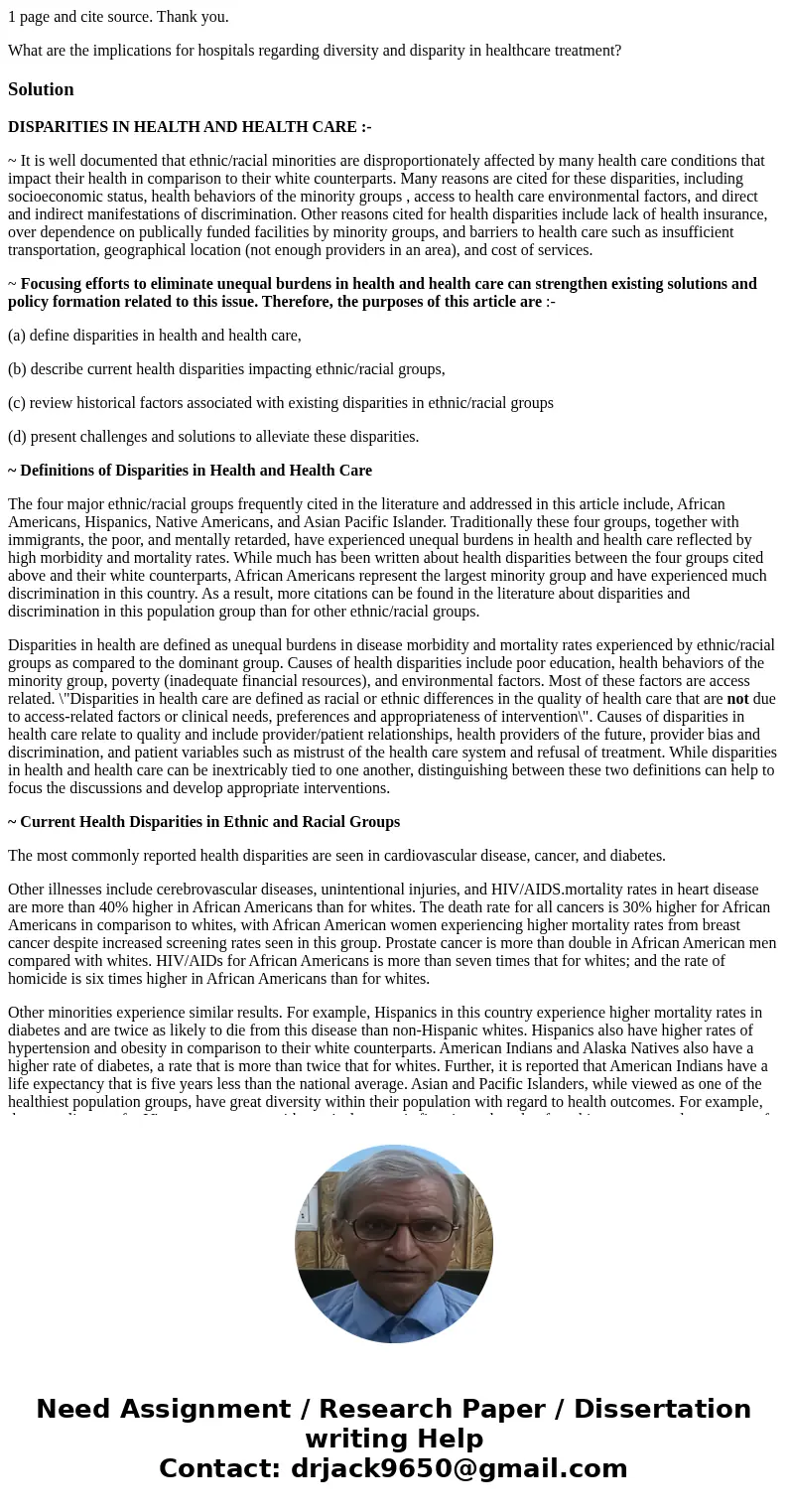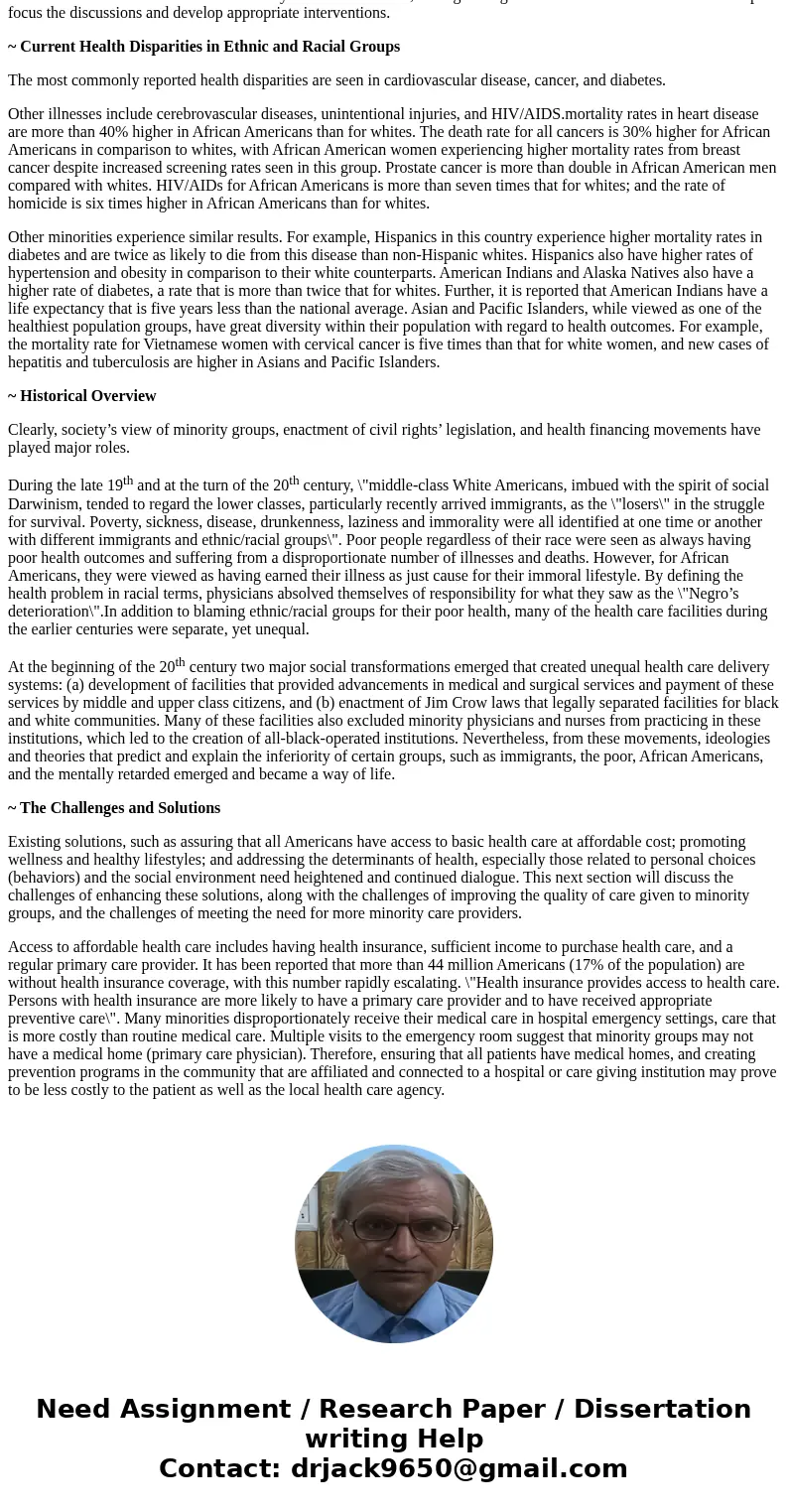1 page and cite source Thank you What are the implications f
1 page and cite source. Thank you.
What are the implications for hospitals regarding diversity and disparity in healthcare treatment?
Solution
DISPARITIES IN HEALTH AND HEALTH CARE :-
~ It is well documented that ethnic/racial minorities are disproportionately affected by many health care conditions that impact their health in comparison to their white counterparts. Many reasons are cited for these disparities, including socioeconomic status, health behaviors of the minority groups , access to health care environmental factors, and direct and indirect manifestations of discrimination. Other reasons cited for health disparities include lack of health insurance, over dependence on publically funded facilities by minority groups, and barriers to health care such as insufficient transportation, geographical location (not enough providers in an area), and cost of services.
~ Focusing efforts to eliminate unequal burdens in health and health care can strengthen existing solutions and policy formation related to this issue. Therefore, the purposes of this article are :-
(a) define disparities in health and health care,
(b) describe current health disparities impacting ethnic/racial groups,
(c) review historical factors associated with existing disparities in ethnic/racial groups
(d) present challenges and solutions to alleviate these disparities.
~ Definitions of Disparities in Health and Health Care
The four major ethnic/racial groups frequently cited in the literature and addressed in this article include, African Americans, Hispanics, Native Americans, and Asian Pacific Islander. Traditionally these four groups, together with immigrants, the poor, and mentally retarded, have experienced unequal burdens in health and health care reflected by high morbidity and mortality rates. While much has been written about health disparities between the four groups cited above and their white counterparts, African Americans represent the largest minority group and have experienced much discrimination in this country. As a result, more citations can be found in the literature about disparities and discrimination in this population group than for other ethnic/racial groups.
Disparities in health are defined as unequal burdens in disease morbidity and mortality rates experienced by ethnic/racial groups as compared to the dominant group. Causes of health disparities include poor education, health behaviors of the minority group, poverty (inadequate financial resources), and environmental factors. Most of these factors are access related. \"Disparities in health care are defined as racial or ethnic differences in the quality of health care that are not due to access-related factors or clinical needs, preferences and appropriateness of intervention\". Causes of disparities in health care relate to quality and include provider/patient relationships, health providers of the future, provider bias and discrimination, and patient variables such as mistrust of the health care system and refusal of treatment. While disparities in health and health care can be inextricably tied to one another, distinguishing between these two definitions can help to focus the discussions and develop appropriate interventions.
~ Current Health Disparities in Ethnic and Racial Groups
The most commonly reported health disparities are seen in cardiovascular disease, cancer, and diabetes.
Other illnesses include cerebrovascular diseases, unintentional injuries, and HIV/AIDS.mortality rates in heart disease are more than 40% higher in African Americans than for whites. The death rate for all cancers is 30% higher for African Americans in comparison to whites, with African American women experiencing higher mortality rates from breast cancer despite increased screening rates seen in this group. Prostate cancer is more than double in African American men compared with whites. HIV/AIDs for African Americans is more than seven times that for whites; and the rate of homicide is six times higher in African Americans than for whites.
Other minorities experience similar results. For example, Hispanics in this country experience higher mortality rates in diabetes and are twice as likely to die from this disease than non-Hispanic whites. Hispanics also have higher rates of hypertension and obesity in comparison to their white counterparts. American Indians and Alaska Natives also have a higher rate of diabetes, a rate that is more than twice that for whites. Further, it is reported that American Indians have a life expectancy that is five years less than the national average. Asian and Pacific Islanders, while viewed as one of the healthiest population groups, have great diversity within their population with regard to health outcomes. For example, the mortality rate for Vietnamese women with cervical cancer is five times than that for white women, and new cases of hepatitis and tuberculosis are higher in Asians and Pacific Islanders.
~ Historical Overview
Clearly, society’s view of minority groups, enactment of civil rights’ legislation, and health financing movements have played major roles.
During the late 19th and at the turn of the 20th century, \"middle-class White Americans, imbued with the spirit of social Darwinism, tended to regard the lower classes, particularly recently arrived immigrants, as the \"losers\" in the struggle for survival. Poverty, sickness, disease, drunkenness, laziness and immorality were all identified at one time or another with different immigrants and ethnic/racial groups\". Poor people regardless of their race were seen as always having poor health outcomes and suffering from a disproportionate number of illnesses and deaths. However, for African Americans, they were viewed as having earned their illness as just cause for their immoral lifestyle. By defining the health problem in racial terms, physicians absolved themselves of responsibility for what they saw as the \"Negro’s deterioration\".In addition to blaming ethnic/racial groups for their poor health, many of the health care facilities during the earlier centuries were separate, yet unequal.
At the beginning of the 20th century two major social transformations emerged that created unequal health care delivery systems: (a) development of facilities that provided advancements in medical and surgical services and payment of these services by middle and upper class citizens, and (b) enactment of Jim Crow laws that legally separated facilities for black and white communities. Many of these facilities also excluded minority physicians and nurses from practicing in these institutions, which led to the creation of all-black-operated institutions. Nevertheless, from these movements, ideologies and theories that predict and explain the inferiority of certain groups, such as immigrants, the poor, African Americans, and the mentally retarded emerged and became a way of life.
~ The Challenges and Solutions
Existing solutions, such as assuring that all Americans have access to basic health care at affordable cost; promoting wellness and healthy lifestyles; and addressing the determinants of health, especially those related to personal choices (behaviors) and the social environment need heightened and continued dialogue. This next section will discuss the challenges of enhancing these solutions, along with the challenges of improving the quality of care given to minority groups, and the challenges of meeting the need for more minority care providers.
Access to affordable health care includes having health insurance, sufficient income to purchase health care, and a regular primary care provider. It has been reported that more than 44 million Americans (17% of the population) are without health insurance coverage, with this number rapidly escalating. \"Health insurance provides access to health care. Persons with health insurance are more likely to have a primary care provider and to have received appropriate preventive care\". Many minorities disproportionately receive their medical care in hospital emergency settings, care that is more costly than routine medical care. Multiple visits to the emergency room suggest that minority groups may not have a medical home (primary care physician). Therefore, ensuring that all patients have medical homes, and creating prevention programs in the community that are affiliated and connected to a hospital or care giving institution may prove to be less costly to the patient as well as the local health care agency.


 Homework Sourse
Homework Sourse